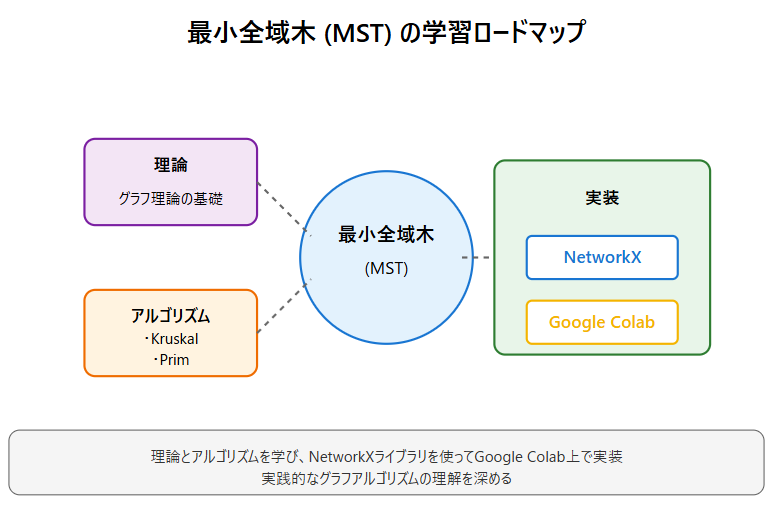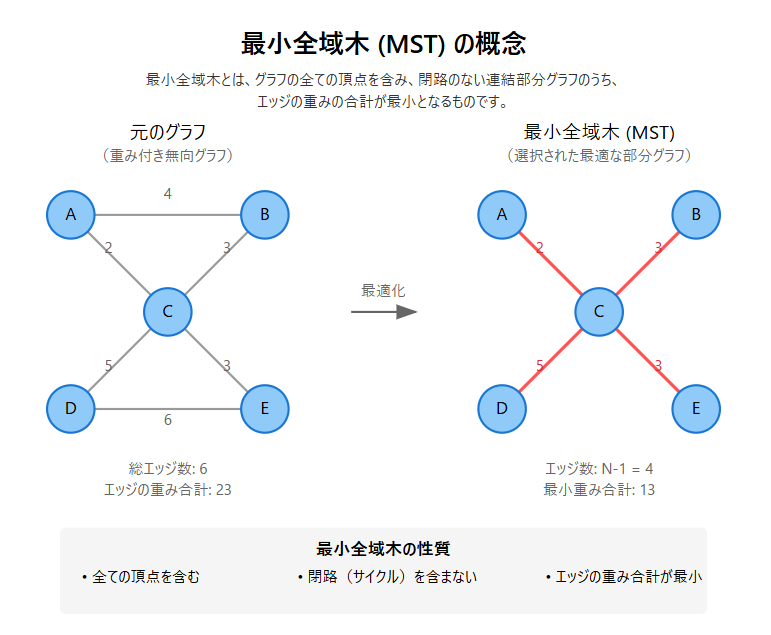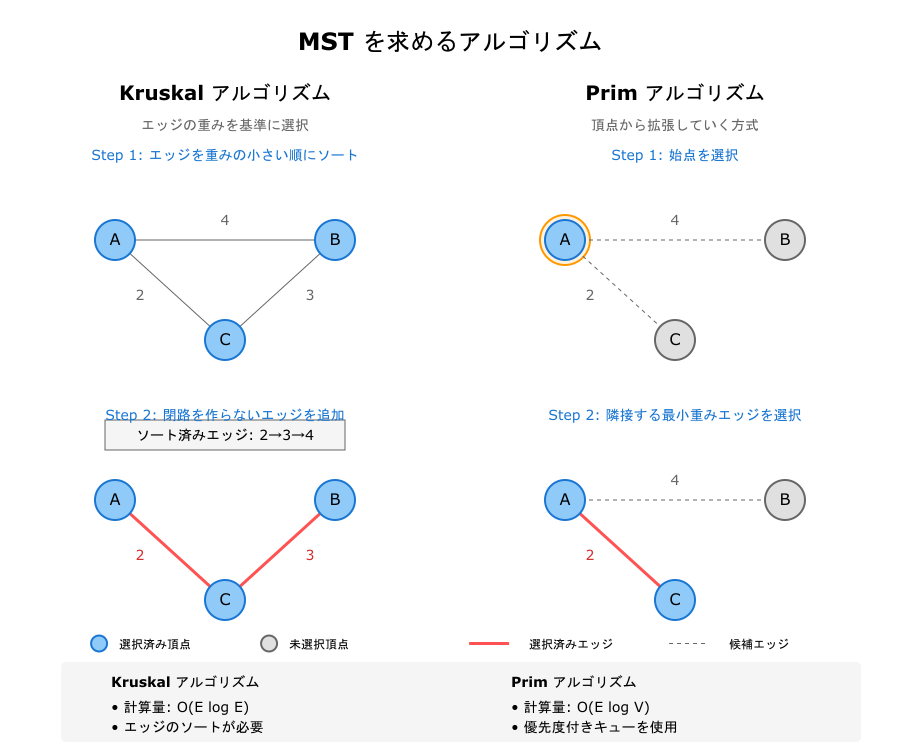はじめに
この記事では、最小全域木 (Minimum Spanning Tree, MST) の概念と理論、具体的なアルゴリズム (Kruskal/Prim) を解説します。また、Python の NetworkX ライブラリを用いた実装例を紹介し、Google Colab 上で簡単に実行可能なサンプルコードを提供します。
1. 最小全域木とは?
定義
- 全域木 (Spanning Tree): グラフの全ての頂点を繋げるが、閉路 (サイクル) を含まない部分グラフ。
- 最小全域木 (MST): 全域木の中で、エッジの重みの合計が最小となるもの。
応用例
- ネットワーク設計: ケーブルの長さやコストを最小限に抑えた配線計画。
- クラスタリング: 最も長いエッジをカットしてクラスタを分ける手法。
- 画像セグメンテーション: 画像をグラフとして扱い、セグメント化を行う。
2. MST を求めるアルゴリズム
2.1 Kruskal アルゴリズム
- 全てのエッジを重みの小さい順にソートする。
- 順にエッジを取り出し、閉路ができない場合に採用する。
- エッジ数が ( V-1 ) 本になるまで続ける。
計算量:
( O(E \log E) ) (エッジのソートがボトルネック)。
2.2 Prim アルゴリズム
- 任意の頂点を選び、木 (MST) を開始する。
- 現在の木に接続可能な最小重みのエッジを選ぶ。
- 全ての頂点が含まれるまで繰り返す。
計算量:
( O(E \log V) ) (優先度付きキューを用いる場合)。
3. NetworkX を使った実装例
以下のコードは Python の NetworkX を使って MST を求める例です。Google Colab などでコピー&ペーストして実行できます。
# Install necessary libraries (if running on Google Colab)
!pip install networkx matplotlib
# Import libraries
import networkx as nx
import matplotlib.pyplot as plt
# Create a graph
G = nx.Graph()
# Add nodes and weighted edges
G.add_edges_from([
("A", "B", 4), ("A", "C", 2), ("B", "C", 1),
("B", "D", 5), ("C", "D", 8), ("C", "E", 10), ("D", "E", 2)
])
# MST の計算
# デフォルトでは Kruskal アルゴリズムが使用されます
mst = nx.minimum_spanning_tree(G)
# Prim アルゴリズムを使用する場合は以下のいずれかを使用します
# mst = nx.minimum_spanning_tree(G, algorithm='prim')
# Print edges in the MST
print("Edges in the MST:", list(mst.edges(data=True)))
# Visualize the graph and MST
pos = nx.spring_layout(G, seed=42)
plt.figure(figsize=(8, 6))
# Draw the original graph
nx.draw(G, pos, with_labels=True, node_color='lightblue', edge_color='gray', node_size=800)
nx.draw_networkx_edge_labels(G, pos, edge_labels=nx.get_edge_attributes(G, 'weight'))
# Highlight the MST edges
nx.draw_networkx_edges(G, pos, edgelist=mst.edges, edge_color='red', width=2)
plt.title("Minimum Spanning Tree (MST)")
plt.show()
4. まとめ
- 最小全域木 (MST) は、ネットワーク設計やクラスタリングなど、様々な応用が可能な重要な概念です。
- Kruskal アルゴリズムと Prim アルゴリズムは MST を効率的に求める手法として広く使われています。
- Python の NetworkX ライブラリを活用すると、MST の計算と可視化が簡単に行えます。
参考文献
実装例: ノートブック
{
"cells": [
{
"cell_type": "markdown",
"id": "c9b2b726",
"metadata": {},
"source": [
"# Minimum Spanning Tree (MST) Example with NetworkX"
]
},
{
"cell_type": "code",
"execution_count": null,
"id": "5f0dd9ad",
"metadata": {},
"outputs": [],
"source": [
"\n",
"# Install necessary libraries (if running on Google Colab)\n",
"!pip install networkx matplotlib\n"
]
},
{
"cell_type": "code",
"execution_count": null,
"id": "88c0d7be",
"metadata": {},
"outputs": [],
"source": [
"\n",
"# Import libraries\n",
"import networkx as nx\n",
"import matplotlib.pyplot as plt\n",
"\n",
"# Create a Graph object\n",
"G = nx.Graph()\n",
"\n",
"# Add nodes (labeled in English letters)\n",
"G.add_nodes_from([\"A\", \"B\", \"C\", \"D\", \"E\"])\n",
"\n",
"# Define edges as (node1, node2, weight)\n",
"edges = [\n",
" (\"A\", \"B\", 4),\n",
" (\"A\", \"C\", 2),\n",
" (\"B\", \"C\", 1),\n",
" (\"B\", \"D\", 5),\n",
" (\"C\", \"D\", 8),\n",
" (\"C\", \"E\", 10),\n",
" (\"D\", \"E\", 2)\n",
"]\n",
"\n",
"# Add edges with weights\n",
"for u, v, w in edges:\n",
" G.add_edge(u, v, weight=w)\n",
"\n",
"# Calculate the Minimum Spanning Tree\n",
"mst = nx.minimum_spanning_tree(G)\n",
"\n",
"# Extract edges from MST\n",
"mst_edges = list(mst.edges(data=True))\n",
"print(\"Edges in the MST:\", mst_edges)\n",
"\n",
"# Draw the original graph and MST\n",
"pos = nx.spring_layout(G, seed=42)\n",
"plt.figure(figsize=(8,6))\n",
"\n",
"# Draw the original graph in gray\n",
"nx.draw_networkx(\n",
" G, pos, \n",
" node_color='lightblue', \n",
" edge_color='gray',\n",
" with_labels=True,\n",
" node_size=800\n",
")\n",
"\n",
"# Highlight MST edges in red\n",
"mst_edge_list = [(u, v) for (u, v, d) in mst_edges]\n",
"nx.draw_networkx_edges(G, pos, edgelist=mst_edge_list, edge_color='red', width=2)\n",
"\n",
"# Show edge weights\n",
"edge_labels = {(u, v): d['weight'] for (u, v, d) in G.edges(data=True)}\n",
"nx.draw_networkx_edge_labels(G, pos, edge_labels=edge_labels)\n",
"\n",
"plt.title(\"MST (Red edges represent the Minimum Spanning Tree)\")\n",
"plt.axis('off')\n",
"plt.show()\n"
]
}
],
"metadata": {},
"nbformat": 4,
"nbformat_minor": 5
}




